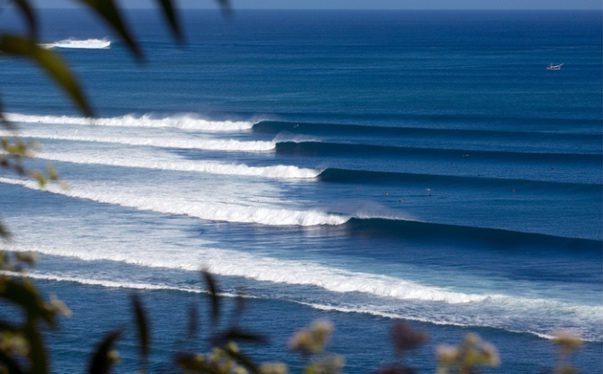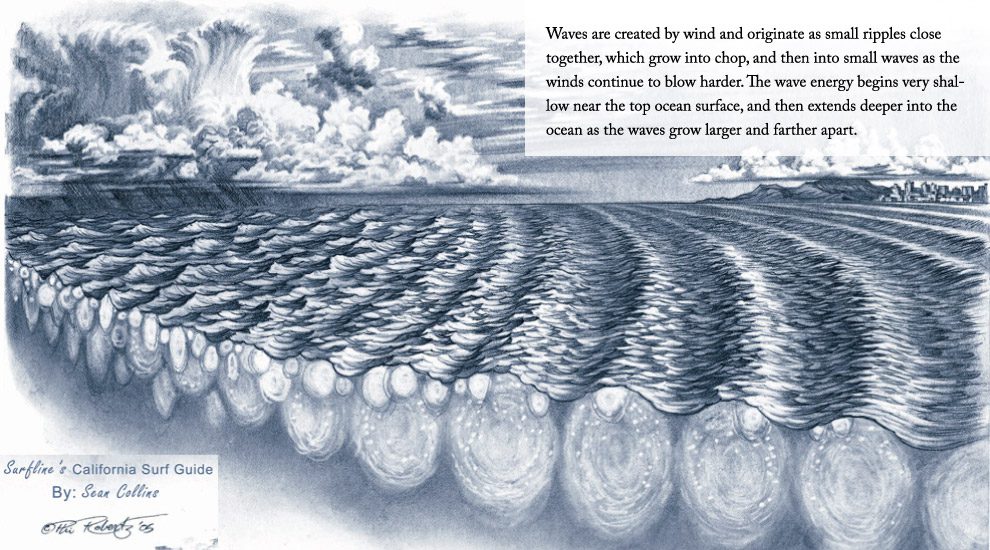
The Importance of Swell Period
As it relates to surfing, we call the distance between 2 consecutive waves ,Swell Period, and it is measured in seconds. So let’s imagine for a moment you are out in the water, waiting on your board as a set of waves begins to pulse through. None of the waves have that perfect wedge you’ve been waiting for, so you just casually float over like a buoy. At the crest of the first wave, begin counting: 1 Mississippi, 2 Mississippi, 3 Mississippi…. and so forth. Stop counting at the crest of the following wave and you will have just taken your first swell period reading!
Now that we know what swell period is, we can use the data to read deeper into the swell’s signature. Imagine again (this is fun, right?!) that we are standing along a glassy pond with a big rock in our hand. As we throw the rock into the center, there is a large splash followed by closely spaced ringlets and confused water around the impact. As the ringlets percolate away from the splash, the chaotic energy organizes into swell lines and begin spacing apart. The same effect happens in the ocean. As the wave energy travels away from their initial source (wind), they coalesce into swell lines while gaining distance between them. Depending on how many seconds you are counting between consecutive waves, you can roughly determine how far the waves have traveled to crash along your beach. If there are only 6 seconds between the waves, you can assume the short-period swell was generated by local winds within a few 100 miles off the coast. However, if you count 14 seconds (or more), you can assume these long period swells traversed the ocean for 1000’s of miles before reaching the coastline. Generally, swell periods can range anywhere from4 to 22 seconds.
Not only can you tell how far the waves have traveled, but also how much underwater energy the wave carries with it. In fact, there is a handy equation for determining the underwater energy of waves. Take the swell period, square it, and multiply the answer by 2.56. The answer will give you the depth (in feet) at which the wave begins to feel the bottom of the ocean. So let’s take a 15 second swell for example. (15 x 15) = 225. And, 225 x 2.56 = 576 ft. So, a 15 second period swell begins “feeling” the bottom of the ocean at 576 ft! So next time you see a buoy reading that says 3 ft at 15 seconds vs. 3ft at 6 seconds, you will know the real difference is what you can’t see underwater. In fact, the 3-footer at 15 seconds may triple its size when it actually breaks.
So what does this all mean for surfing? How does knowing this allow us to improve our “skunk vs. score ratio”. Basically, without giving away too many secrets, point breaks, reefs, and canyon waves are able to focus long-period waves much better than flat, sandy beach breaks. The downward energy of long period swells feel the bottom contours of the ocean and are able to wrap, refract, and magnify as they approach the shore. On the other hand, most beach breaks prefer short – medium period swells to avoid big, walled up, close-outs. In Costa Rica, most of our swells originate from far away in the South Pacific (March – November) or the North Pacific (November – March) offering medium – long period swells throughout the year.
There is much more info about swell period out there. Be sure to read up, familiarize yourself with your local spots, and get out there and score! As always, feel free to contact me with questions, topic requests, and comments at Ryan@witchsrock.com.
See you out in the water!
Ryan Waldron
Witch’s Rock Surf Camp


